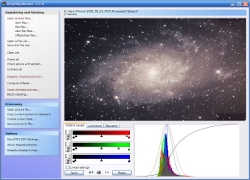Astronomical Image Processing

Summary
The module begins with a look at how images of the night sky are captured and stored using modern telescopes. After building a basic pinhole camera, we investigate how telescope optics are used to collect and manipulate light. Students then look at how captured observations, otherwise known as image data, can be viewed and analysed using basic image processing software. The module then investigates the use of colour filters, and how multi-filter images can be combined to create a 3-colour image. We finish with a practical activity that investigates a few of the more advanced techniques used by astronomers to explore the night sky.
Age Range
11 – 16
Duration
45 minutes
Module Composition
- Working with Telescope Data – Presentation
- Pinhole Cameras – Practical Activity
- Basic Image Processing – Practical Activity
- 3-Colour Imaging – Presentation
- Advanced Image Processing – Practical Activity
Extension Activities
- Go Observing – observing with the robotic Liverpool Telescope.
- Beginner’s Guide – to astronomical image processing.
- SalsaJ – advanced free astronomical image processing software.

Follow Us: